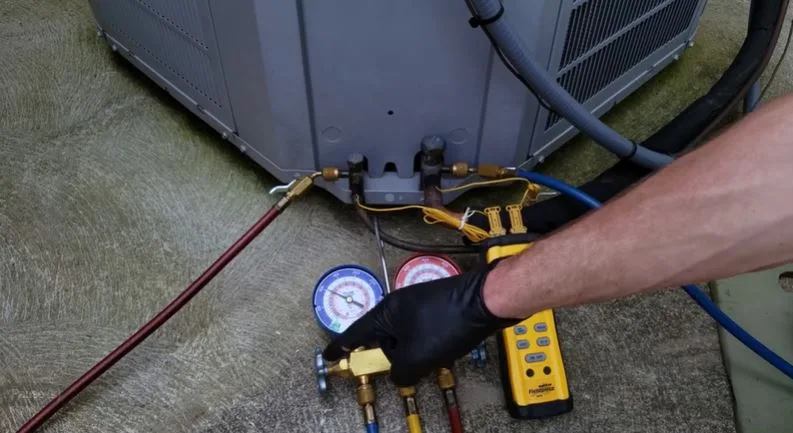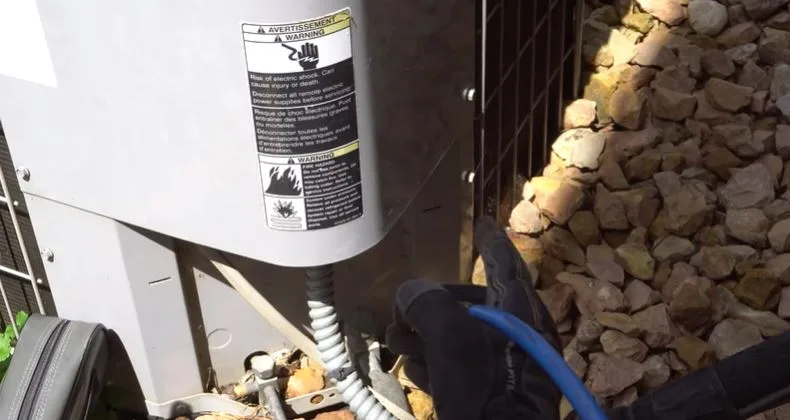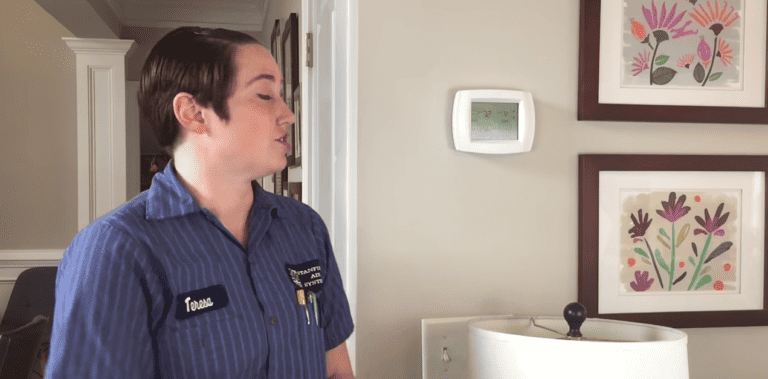How to Fix Low Superheat High Subcooling
Low superheat and high subcool can mean a lot when troubleshooting problems with air conditioning systems. So what can really cause low superheat high subcooling and how can it be fixed?
In many cases, a low superheat and high subcool is caused by excessive refrigerant charge in air conditioning systems. The problem can be fixed by discharging excess refrigerant from an air conditioning system.

In this guide, we are going to look at what low superheat is and what causes it. Then we will look at what high subcooling is and what causes it. Finally we’ll look at what causes a low superheat with a high subcooling.
Read also: AC high pressure line hot or cold?
What causes low superheat
Superheat indicates how much refrigerant is in the evaporator coils. And low superheat means there isn’t enough heat load in the evaporator coil or there is excess amount of the refrigerant in the evaporator coil.
Low superheat can be caused by a few issues which include
- Overcharged AC system
- Restricted airflow to the evaporator coil( which can be causes by dirty air filters
- Overfeeding of the metering device.
- Oversized AC system
The possible causes of low superheat and the main fixes can be best summarized in the following table.
| Possible cause | Main fix |
| Excessive refrigerant in the ac system | Discharge some refrigerant |
| Restricted air flow to the evaporator | Replace air filters and the blower wheel |
| Overfeeding of the metering device | Ensure sensing valve of the TXV is properly insulated |
| Insufficient heat load to the coil | Clean the filters and the coil |
| Oversized AC system | Consider going for a well Sized AC unit |
Read also: How to Fix High Superheat Low Subcooling
1) Excessive refrigerant in the ac system
If there is excessive refrigerant going to the evaporator coil, this can cause more liquid refrigerant to get into the evaporator coil. When there is more liquid in the evaporator coils, less heat will be absorbed.
That is because under normal circumstances, the heat is absorbed by the process of evaporation of the refrigerant.
When there is less evaporation taking place with more liquid refrigerant that is now referred to has low superheat.
Consequently more liquid refrigerant may enter the compressor and this could damage the compressor. Since the compressor is designed to compress the gaseous refrigerant.
Excessive refrigerant getting into the can be caused by a bad TXV valve or one that is stuck open.
The problem can be fixed by discharging some refridgerant from the AC system to the correct levels
2) Restricted air flow to the evaporator
When there isn’t enough air going to the evaporator coil, there will be less absorption of heat from the air and this eventually may cause low superheat. Restrict air to the evaporator coil can be caused by:
Dirty evaporator coil:Dirty coils or coils that have build up on them will significantly reduce the open surface area of the coil. This will in turn reduce that amount of air coming into contract with the coil.
Dirty air filter: Dirt or clogged air filters will also restrict airflow to the evaporator coil. That is because air enters through the filter before reaching the coils. So when they are clogged or they have fewer spaces for air to pass, only little air will pass through to the coil and this may in turn cause only little absorption of heat by the evaporator.
Solution
In both cases, we can address this issue by always keeping the evaporator coil and the air filter clean. When filters skip scheduled replacements or cleaning, this typically causes the coils to become dirty in the long run. So by cleaning the coils and replacing the air filter, low superheat can be fixed.
3) Overfeeding of the metering device
A metering device that is not properly insulated will allow excess refrigerant to the evaporator coil and this can cause flooding. To avoid overfeeding of the metering device it should be properly insulated.
4) Oversized AC system
When you have an oversized AC system, there won’t be enough heat load to vaporize the refrigerant at evaporator coils. This may result in low superheat.
Solution
To fix this problem ensure that you are using the correct size of an HVAC equipment.
How to determine whether you have Low or high superheat on an AC
There is a simple method you can use to determine how to check superheat. And then if you have insufficient heat load to the evaporator, this will give you a low superheat. When you have insufficient refrigerant going to the evaporator, then you’ll have a high superheat
To perform this check you will need
- A thermometer (specifically designed for taking pip temperature
- Temperature/ pressure chart for converting the temperature to the pressure
Procedure
- By using the thermometer take the temperature on the suction line. and convert this temperature to pressure(psi) using the temperature.
- Take the pressure at the suction line, and convert it to the temperature using the temperature pressure chart.
- Take the difference f the two temperatures
- Normal superheat for any system will be about 10°F measured at the evaporator and about 20°F to 25°F measured near the compressor.
- You will have low superheat if the difference between the two temperature is the evaporator is <10°F and if it’s <20°F
- You will have a high superheat if the readings are >10°F at
- the evaporator and >10°F near the compressor.

Example
If the pressure measured at the suction line is 65 psi on a R-22 system. 65 psi on the temperature pressure chart will give us 38°F. And if the temperature measured on the suction line was 68°F. The difference between the two temperatures is 30°F.
30°F>the normal 10°F so in this case, you have a high superheat. If the difference was under 10°F that was going to be low superheat.
Alsor Read: What causes no condensation from AC?
What causes high subcool
Subcool indicates the amount of refrigerant backing up in the condenser unit. So high subcool refers to a condition where you have excess refrigerant backing up in the condenser unit. High subcool can also be caused by a few issue which include the following
- Overcharged AC system
- Undersized or failing closed metering device
- Restriction of the liquid line for example a kinkled line
The causes of high subcool together with their fixes can be summarized in the following table
| Possible cause | Main fix |
| Overcharged AC system | Discharge some refrigerant |
| Faulty metering device | User well sized metering device |
| Restriction of the liquid line | Ensure lines are not restricted, straight kinkled lines |
1) Overcharging the system will cause high subcool.
When there is excess refrigerant in the system, condensation and evaporation do not take place the way they should. Instead excess refrigerant will be backing up in the condenser unit.
2) Faulty metering device
Issues with a metering device could be another cause for high subcooling. This also includes a metering device that is underfeeing, undersized or a fault in the head pressure control system,
3) Restriction of the liquid line
Solution
Discharging some of the refrigerant to the correct or standard levels can solve the problem. But for you to do this, verify it’s actually the refrigerant that is in excess. Sometimes a high subcool with a high superheat can be caused by a defective or malfunctioning metering device.
What causes Low superheat with high subcool
Now that we have learnt what causes low superheat and we have also looked at what causes high subcool. Let’s now look at conditions where you have a low superheat and a high subcool at the same time.
This condition can only be caused by having excessive refrigerant in the system overall. Overcharging the AC with the refrigerant will cause Low superheat high subcool.
How to determine if you have a low or high subcool
Check subcooling you will typically need to take the temperature at the liquid line near the condenser.
Then take the head pressure and convert it to the temperature on the pressure-temperatures chart.
Example
When I take the head pressure and the reading is 260 psi. When this is converted to temperature this gives me 120°F.
Then you’ll need to attach a thermostat to the liquid line and record the temperature is 85°F, then;
120°F-85°F=35°F in this case, you have high subcool because;
Normal range on systems that use a thermostatic expansion valve (TXV) is 10°F-18°F. And anything lower will be low subcool
Final thoughts
Now that you have learnt what causes low superheat high subcool, we hope that you have fixed this problem on the system you are working on. Thank you for your continued support reading our guides. If you have any further questions send us an email and we’ll be glad to help.
Shalom.
More resources
https://www.youtube.com/watch?v=pUYLmxOrfo0&t=196sds
https://www.achrnews.com/articles/92006-diagnosing-a-restricted-metering-device
![Bradford White Water Heater Pilot Wont Light [Fixed]](https://thermostating.com/wp-content/uploads/2023/03/gas-control-knob-2-768x434.webp)
![Nest Thermostat Showing Offline In App But Connected To Wifi? [Fixed]](https://thermostating.com/wp-content/uploads/2023/05/nest-offline-in-app-768x433.jpg)
![Sensi Thermostat Blowing Cold Air On Heat [Fixed]](https://thermostating.com/wp-content/uploads/2023/01/sensi-display-768x381.webp)
![No Condensation from AC And No Cooling[Solved]](https://thermostating.com/wp-content/uploads/2023/01/condensate-pipe-jpg.webp)

![Dometic Thermostat E1 Code [Causes + Fix]](https://thermostating.com/wp-content/uploads/2022/12/Dometic-thermostat-768x387.webp)